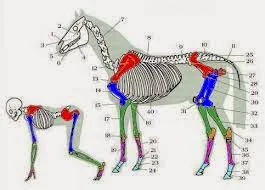 |
| Facts About Navicular Disease In Horses |
Through the years, horses have proved themselves to be one of the most helpful domestic animal known to man. If dogs are used for hunting wild animals, horses have been used for transportation services and other means of travel. Equines are also used to control herds. They are even used in police force in pursuit of a criminal back when police cars were not yet thought of.
Today, the most popular quadruped has taken on a different purpose for the public. They are, at present, used for shows, competitions and just for a leisurely walk around very spacious open areas. Superior pedigree quadrupeds are up for the admiration of a swooning crowd during horse dressage. All these gallops, trots and walks can put the hooves on a strain, and can result to <A href="http://www.
The Navicular Syndrome is caused by the irritation of the navicular bone. This particular bone is a common feature in the feet of most animals. Most beasts feel pain with every step due to sore hooves caused about by the said illness. If the illness is not tended to as soon as possible, it may cause the beast to become lame.
There surfaces to be educated guesses made by equine experts as to why this malady exists. One most popular hypothesis revolves around the issue of overexertion. Horses are out on their feet the whole day, so all the pressure just gathers at the hoof which has to support the horse day in and day out. Unregulated horse weight can also add strain on the navicular bone, which can just lead to compression on both the bone and the tendon underneath.
Age does not really contribute to the development of the sickness, contrary to popular belief. Those who are as old as 20 years can develop the disease, also those as young as three years old only. Some very old animals do not even develop the said illness, as it generally hits those equines who are aged seven to nine.
Horse shoes also play an integral role in the development of the said syndrome. Poor trimming, wrong shoe selections and erroneous shoe attachment are only some of the contributing factors. The hooves of quadrupeds, as some experts say, is designed to expand and contract along as the horse grows. By fitting inflexible metals such as the ordinary horse shoes, the growth of the hoof is limited, causing faults in blood flow.
If the horse normally travels on areas that are too rocky and could possibly uneven, the chances of developing navicular disease also increase. Steep hills and sloped ranges cause the horse to give more effort, resulting in hoof disorder. Make your horse work or travel along areas that are conducive for trotting along. For those who are participating in equestrian sports, all the high jumps and gallops that a horse makes will also affect the navicula negatively.
If the beasts are showing signs of lameness, then that could be a giveaway that there is something wrong with its body. The first plan of action an owner should do is to have the shoe examined. It should be adjusted so that it will be more comfortable for the quadruped to walk. Others even suggest putting in a small pad to increase the measure of the angle.
You can also try the administration of drugs to a particular horse. Vets often prescribe anti inflammatory ones to fight off the burns and the soreness. Since the results of the medication will not be the same for all equines, it would be best to take the beast in question to see a medical professional.
<a href="http://www.
------------------------------
You are receiving this because you signed up for it on 2014-05-05 from IP 105.156.196.59
To fine-tune your selection of which articles to receive, just login here:
http://www.
using your username:
To unsubscribe please use the following link:
http://www.
------------------------------
------------------------------
New Unique Article!
Title: Facts About Navicular Disease In Horses
Author: Ina Hunt
Email: nathanwebster335@live.com
Keywords: medicine, health, treatment, healthy
Word Count: 613
Category: Medicine
------------------------------

Comments
Post a Comment